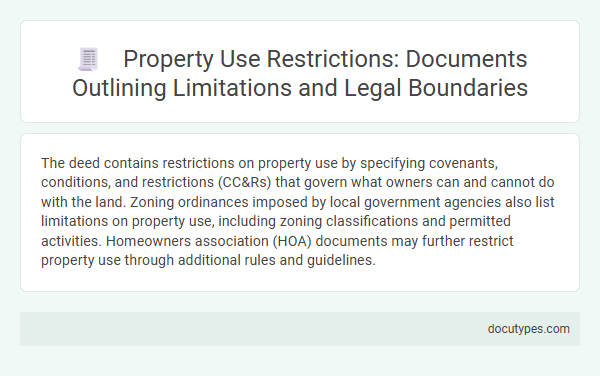The deed contains restrictions on property use by specifying covenants, conditions, and restrictions (CC&Rs) that govern what owners can and cannot do with the land. Zoning ordinances imposed by local government agencies also list limitations on property use, including zoning classifications and permitted activities. Homeowners association (HOA) documents may further restrict property use through additional rules and guidelines.
Introduction to Property Use Restrictions
Which document lists restrictions on property use? Property use restrictions are typically detailed in the deed or title report of a property. These documents outline limitations such as zoning laws, easements, and covenants that affect how the property can be used.
Types of Property Use Restrictive Documents
Property use restrictions are defined in various legal documents that outline limitations on how land or buildings can be utilized. Understanding these documents is essential for property owners, buyers, and developers to ensure compliance with local laws and community standards.
- Zoning Ordinances - Local government laws that regulate land use by dividing areas into zones such as residential, commercial, or industrial.
- Deed Restrictions - Private agreements recorded in property deeds that limit specific uses or alterations of the property.
- Homeowners' Association (HOA) Covenants - Rules set by a homeowners' association that govern property appearance, modifications, and use within a subdivision or community.
Zoning Laws and Their Impact on Property Use
Zoning laws are a critical document listing restrictions on property use, impacting what activities are permitted on your land. These regulations define areas for residential, commercial, industrial, and agricultural purposes, ensuring organized development and compliance with local standards.
- Zoning Ordinances - Official documents issued by local governments specifying permitted uses, building heights, densities, and setbacks for properties within designated zones.
- Zoning Maps - Visual representations that delineate different zoning districts, allowing property owners to understand restrictions applicable to their specific location.
- Land Use Permits - Required authorizations that confirm your property's compliance with zoning laws before undertaking construction or changing its use.
Deed Restrictions: Definition and Purpose
Deed restrictions are legally binding terms included in a property's deed that limit how the land can be used. These restrictions protect neighborhood standards, property values, and community character by preventing certain activities or developments. Your property's deed document typically lists these restrictions, providing clear guidelines on permissible uses.
Covenants, Conditions, and Restrictions (CC&Rs) Explained
The primary document listing restrictions on property use is the Covenants, Conditions, and Restrictions (CC&Rs). These legal guidelines outline what owners can and cannot do on their property within a community or development.
CC&Rs cover rules related to property appearance, modifications, and usage to maintain neighborhood standards. Understanding your CC&Rs ensures compliance and helps protect property values effectively.
Easements and Their Role in Property Limitations
The document that lists restrictions on property use is typically the deed or title report associated with the property. Easements are often detailed within these documents, specifying rights that affect property access and usage.
Easements grant certain parties the legal right to use portions of your property for specific purposes, such as utility lines or access roads. Understanding these limitations is crucial for property owners to know how these easements impact their property's value and use.
Homeowners Association (HOA) Rules and Compliance
The document that lists restrictions on property use is typically the Homeowners Association (HOA) Rules and Regulations. These rules outline specific guidelines for property maintenance, architectural changes, and community behavior to ensure uniformity and preserve property values. Understanding your HOA compliance requirements is essential to avoid fines and disputes within the neighborhood.
Legal Enforcement of Property Use Restrictions
The document that lists restrictions on property use is typically the deed or a restrictive covenant attached to the property. These restrictions are legally enforceable and govern how the property can be utilized by the owner.
- Deed Restrictions - The deed includes specific limitations on property use that run with the land and bind future owners.
- Restrictive Covenants - These are clauses within the deed or separate agreements that impose conditions on property development, occupancy, or usage.
- Enforcement Mechanisms - Violations of use restrictions can lead to legal actions such as injunctions or fines, ensuring compliance.
Legal enforcement of property use restrictions protects community standards and property values through binding agreements documented in official property records.
Common Violations and Legal Consequences
The document that lists restrictions on property use is commonly known as a deed restriction or a restrictive covenant. These restrictions outline specific limitations and obligations imposed on the property owner.
Common violations include unauthorized construction, improper land use, or failure to maintain the property according to community standards. Such breaches can result in fines, legal action, or forced compliance orders. Courts may enforce these restrictions to preserve property value and neighborhood integrity.
Which Document Lists Restrictions on Property Use? Infographic

